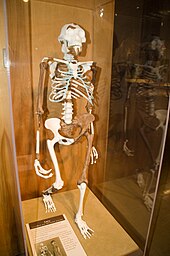A | B | C | D | E | F | G | H | CH | I | J | K | L | M | N | O | P | Q | R | S | T | U | V | W | X | Y | Z | 0 | 1 | 2 | 3 | 4 | 5 | 6 | 7 | 8 | 9
| Human[1] | |
|---|---|
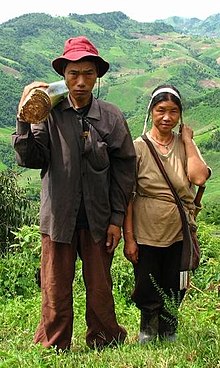
| |
| An adult human male (left) and female (right) (Thailand, 2007) | |
| Scientific classification | |
| Kingdom: | Animalia |
| Phylum: | Chordata |
| Class: | Mammalia |
| Order: | Primates |
| Suborder: | Haplorhini |
| Infraorder: | Simiiformes |
| Family: | Hominidae |
| Subfamily: | Homininae |
| Tribe: | Hominini |
| Genus: | Homo |
| Species: | H. sapiens
|
| Binomial name | |
| Homo sapiens Linnaeus, 1758
| |

| |
| Homo sapiens population density (2005) | |
Humans (Homo sapiens) are the most abundant and widespread species of primate. They are a type of great ape that is characterized by bipedalism and exceptional cognitive skills due to a large and complex brain. Humans are highly social and tend to live in complex social structures composed of many cooperating and competing groups, from families and kinship networks to political states. As such, social interactions between humans have established a wide variety of values, social norms, languages, and rituals, each of which bolsters human society. The desire to understand and influence phenomena has motivated humanity's development of science, technology, philosophy, mythology, religion, and other fields of study.
Although some scientists equate the term "humans" with all members of the genus Homo, in common usage it generally refers to Homo sapiens, the only extant member. Anatomically modern humans emerged around 300,000 years ago in Africa, evolving from Homo heidelbergensis or a similar species and migrating out of Africa, gradually replacing or interbreeding with local populations of archaic humans. For most of history, humans were nomadic hunter-gatherers. Humans began exhibiting behavioral modernity about 160,000–60,000 years ago. The Neolithic Revolution, which began in Southwest Asia around 13,000 years ago (and separately in a few other places), saw the emergence of agriculture and permanent human settlement. As populations became larger and denser, forms of governance developed within and between communities, and a number of civilizations have risen and fallen. Humans have continued to expand, with a global population of over 8 billion as of 2022[update].
Genes and the environment influence human biological variation in visible characteristics, physiology, disease susceptibility, mental abilities, body size, and life span. Though humans vary in many traits (such as genetic predispositions and physical features), any two humans are at least 99% genetically similar. Humans are sexually dimorphic: generally, males have greater body strength and females have a higher body fat percentage. At puberty, humans develop secondary sexual characteristics. Females are capable of pregnancy, usually between puberty, at around 12 years old, and menopause, around the age of 50.
Humans are omnivorous, capable of consuming a wide variety of plant and animal material, and have used fire and other forms of heat to prepare and cook food since the time of Homo erectus. Humans can survive for up to eight weeks without food and three or four days without water. Humans are generally diurnal, sleeping on average seven to nine hours per day. Childbirth is dangerous, with a high risk of complications and death. Often, both the mother and the father provide care for their children, who are helpless at birth.
Humans have a large, highly developed, and complex prefrontal cortex, the region of the brain associated with higher cognition. They are highly intelligent, capable of episodic memory, have flexible facial expressions, self-awareness, and a theory of mind. The human mind is capable of introspection, private thought, imagination, volition, and forming views on existence. This has allowed great technological advancements and complex tool development to be possible through complex reasoning and the transmission of knowledge to subsequent generations. Language, art, and trade are defining characteristics of humans. Long-distance trade routes might have led to cultural explosions and resource distribution that gave humans an advantage over other similar species.
Etymology and definition
All modern humans are classified into the species Homo sapiens, coined by Carl Linnaeus in his 1735 work Systema Naturae.[2] The generic name "Homo" is a learned 18th-century derivation from Latin homō, which refers to humans of either sex.[3][4] The word human can refer to all members of the Homo genus,[5] although in common usage it generally just refers to Homo sapiens, the only extant species.[6] The name "Homo sapiens" means 'wise man' or 'knowledgeable man'.[7] There is disagreement if certain extinct members of the genus, namely Neanderthals, should be included as a separate species of humans or as a subspecies of H. sapiens.[5]
Human is a loanword of Middle English from Old French humain, ultimately from Latin hūmānus, the adjectival form of homō ('man' — in the sense of humankind).[8] The native English term man can refer to the species generally (a synonym for humanity) as well as to human males. It may also refer to individuals of either sex, though this form is less common in contemporary English.[9]
Despite the fact that the word animal is colloquially used as an antonym for human,[10] and contrary to a common biological misconception, humans are animals.[11] The word person is often used interchangeably with human, but philosophical debate exists as to whether personhood applies to all humans or all sentient beings, and further if one can lose personhood (such as by going into a persistent vegetative state).[12]
Evolution
Humans are apes (superfamily Hominoidea).[13] The lineage of apes that eventually gave rise to humans first split from gibbons (family Hylobatidae) and orangutans (genus Pongo), then gorillas (genus Gorilla), and finally, chimpanzees and bonobos (genus Pan). The last split, between the human and chimpanzee–bonobo lineages, took place around 8–4 million years ago, in the late Miocene epoch.[14][15] During this split, chromosome 2 was formed from the joining of two other chromosomes, leaving humans with only 23 pairs of chromosomes, compared to 24 for the other apes.[16] Following their split with chimpanzees and bonobos, the hominins diversified into many species and at least two distinct genera. All but one of these lineages—representing the genus Homo and its sole extant species Homo sapiens—are now extinct.[17]
| Hominoidea (hominoids, apes) |
| ||||||||||||||||||||||||||||||||||||||||||||||||||||||||||||
The genus Homo evolved from Australopithecus.[18][19] Though fossils from the transition are scarce, the earliest members of Homo share several key traits with Australopithecus.[20][21] The earliest record of Homo is the 2.8 million-year-old specimen LD 350-1 from Ethiopia, and the earliest named species are Homo habilis and Homo rudolfensis which evolved by 2.3 million years ago.[21] H. erectus (the African variant is sometimes called H. ergaster) evolved 2 million years ago and was the first archaic human species to leave Africa and disperse across Eurasia.[22] H. erectus also was the first to evolve a characteristically human body plan. Homo sapiens emerged in Africa around 300,000 years ago from a species commonly designated as either H. heidelbergensis or H. rhodesiensis, the descendants of H. erectus that remained in Africa.[23] H. sapiens migrated out of the continent, gradually replacing or interbreeding with local populations of archaic humans.[24][25][26] Humans began exhibiting behavioral modernity about 160,000-70,000 years ago,[27] and possibly earlier.[28]
The "out of Africa" migration took place in at least two waves, the first around 130,000 to 100,000 years ago, the second (Southern Dispersal) around 70,000 to 50,000 years ago.[29][30] H. sapiens proceeded to colonize all the continents and larger islands, arriving in Eurasia 125,000 years ago,[31][32] Australia around 65,000 years ago,[33] the Americas around 15,000 years ago, and remote islands such as Hawaii, Easter Island, Madagascar, and New Zealand between the years 300 and 1280 CE.[34][35]
Human evolution was not a simple linear or branched progression but involved interbreeding between related species.[36][37][38] Genomic research has shown that hybridization between substantially diverged lineages was common in human evolution.[39] DNA evidence suggests that several genes of Neanderthal origin are present among all non sub-Saharan African populations, and Neanderthals and other hominins, such as Denisovans, may have contributed up to 6% of their genome to present-day non sub-Saharan African humans.[36][40][41]
Human evolution is characterized by a number of morphological, developmental, physiological, and behavioral changes that have taken place since the split between the last common ancestor of humans and chimpanzees. The most significant of these adaptations are obligate bipedalism, increased brain size and decreased sexual dimorphism (neoteny). The relationship between all these changes is the subject of ongoing debate.[42]
History
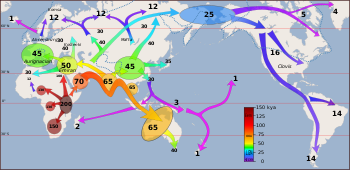
Until about 12,000 years ago, all humans lived as hunter-gatherers.[43][44] The Neolithic Revolution (the invention of agriculture) first took place in Southwest Asia and spread through large parts of the Old World over the following millennia.[45] It also occurred independently in Mesoamerica (about 6,000 years ago),[46] China,[47][48] Papua New Guinea,[49] and the Sahel and West Savanna regions of Africa.[50][51][52] Access to food surplus led to the formation of permanent human settlements, the domestication of animals and the use of metal tools for the first time in history. Agriculture and sedentary lifestyle led to the emergence of early civilizations.[53][54][55]
An urban revolution took place in the 4th millennium BCE with the development of city-states, particularly Sumerian cities located in Mesopotamia.[56] It was in these cities that the earliest known form of writing, cuneiform script, appeared around 3000 BCE.[57] Other major civilizations to develop around this time were Ancient Egypt and the Indus Valley Civilisation.[58] They eventually traded with each other and invented technology such as wheels, plows and sails.[59][60][61][62] Astronomy and mathematics were also developed and the Great Pyramid of Giza was built.[63][64][65] There is evidence of a severe drought lasting about a hundred years that may have caused the decline of these civilizations,[66] with new ones appearing in the aftermath. Babylonians came to dominate Mesopotamia while others,[67] such as Poverty Point cultures, Minoans and the Shang dynasty, rose to prominence in new areas.[68][69][70] The Bronze Age suddenly collapsed around 1200 BCE, resulting in the disappearance of a number of civilizations and the beginning of the Greek Dark Ages.[71][72] During this period iron started replacing bronze, leading to the Iron Age.[73]
In the 5th century BCE, history started being recorded as a discipline, which provided a much clearer picture of life at the time.[74] Between the 8th and 6th century BCE, Europe entered the classical antiquity age, a period when ancient Greece and ancient Rome flourished.[75][76] Around this time other civilizations also came to prominence. The Maya civilization started to build cities and create complex calendars.[77][78] In Africa, the Kingdom of Aksum overtook the declining Kingdom of Kush and facilitated trade between India and the Mediterranean.[79] In West Asia, the Achaemenid Empire's system of centralized governance became the precursor to many later empires,[80] while the Gupta Empire in India and the Han dynasty in China have been described as golden ages in their respective regions.[81][82]

Following the fall of the Western Roman Empire in 476, Europe entered the Middle Ages.[83] During this period, Christianity and the Church would provide centralized authority and education.[84] In the Middle East, Islam became the prominent religion and expanded into North Africa. It led to an Islamic Golden Age, inspiring achievements in architecture, the revival of old advances in science and technology, and the formation of a distinct way of life.[85][86] The Christian and Islamic worlds would eventually clash, with the Kingdom of England, the Kingdom of France and the Holy Roman Empire declaring a series of holy wars to regain control of the Holy Land from Muslims.[87] In the Americas, complex Mississippian societies would arise starting around 800 CE,[88] while further south, the Aztecs and Incas would become the dominant powers.[89] The Mongol Empire would conquer much of Eurasia in the 13th and 14th centuries.[90] Over this same time period, the Mali Empire in Africa grew to be the largest empire on the continent, stretching from Senegambia to Ivory Coast.[91] Oceania would see the rise of the Tuʻi Tonga Empire which expanded across many islands in the South Pacific.[92]
The early modern period in Europe and the Near East (c.1450–1800) began with the final defeat of the Byzantine Empire, and the rise of the Ottoman Empire.[93] Meanwhile, Japan entered the Edo period,[94] the Qing dynasty rose in China[95] and the Mughal Empire ruled much of India.[96] Europe underwent the Renaissance, starting in the 15th century,[97] and the Age of Discovery began with the exploring and colonizing of new regions.[98] This includes the British Empire expanding to become the world's largest empire[99] and the colonization of the Americas.[100] This expansion led to the Atlantic slave trade[101] and the genocide of Native American peoples.[102] This period also marked the Scientific Revolution, with great advances in mathematics, mechanics, astronomy and physiology.[103]
The late modern period (1800–present) saw the Technological and Industrial Revolution bring such discoveries as imaging technology, major innovations in transport and energy development.[104] The United States of America underwent great change, going from a small group of colonies to one of the global superpowers.[105] The Napoleonic Wars raged through Europe in the early 1800s,[106] Spain lost most of its colonies in the New World,[107] while Europeans continued expansion into Africa—where European control went from 10% to almost 90% in less than 50 years[108]—and Oceania.[109] A tenuous balance of power among European nations collapsed in 1914 with the outbreak of the First World War, one of the deadliest conflicts in history.[110] In the 1930s, a worldwide economic crisis led to the rise of authoritarian regimes and a Second World War, involving almost all of the world's countries.[111] Following its conclusion in 1945, the Cold War between the USSR and the United States saw a struggle for global influence, including a nuclear arms race and a space race.[112][113] The current Information Age sees the world becoming increasingly globalized and interconnected.[114]
Habitat and population

| |
| World population | 8 billion |
|---|---|
| Population density | 16/km2 (41/sq mi) by total area 54/km2 (139/sq mi) by land area |
| Largest cities[n 2] | Tokyo, Delhi, Shanghai, São Paulo, Mexico City, Cairo, Mumbai, Beijing, Dhaka, Osaka, New York-Newark, Karachi, Buenos Aires, Chongqing, Istanbul, Kolkata, Manila, Lagos, Rio de Janeiro, Tianjin, Kinshasa, Guangzhou, Los Angeles-Long Beach-Santa Ana, Moscow, Shenzhen, Lahore, Bangalore, Paris, Jakarta, Chennai, Lima, Bogota, Bangkok, London |
Early human settlements were dependent on proximity to water and—depending on the lifestyle—other natural resources used for subsistence, such as populations of animal prey for hunting and arable land for growing crops and grazing livestock.[118] Modern humans, however, have a great capacity for altering their habitats by means of technology, irrigation, urban planning, construction, deforestation and desertification.[119] Human settlements continue to be vulnerable to natural disasters, especially those placed in hazardous locations and with low quality of construction.[120] Grouping and deliberate habitat alteration is often done with the goals of providing protection, accumulating comforts or material wealth, expanding the available food, improving aesthetics, increasing knowledge or enhancing the exchange of resources.[121]
Humans are one of the most adaptable species, despite having a low or narrow tolerance for many of the earth's extreme environments.[122] Through advanced tools, humans have been able to extend their tolerance to a wide variety of temperatures, humidity, and altitudes.[122] As a result, humans are a cosmopolitan species found in almost all regions of the world, including tropical rainforest, arid desert, extremely cold arctic regions, and heavily polluted cities; in comparison, most other species are confined to a few geographical areas by their limited adaptability.[123] The human population is not, however, uniformly distributed on the Earth's surface, because the population density varies from one region to another, and large stretches of surface are almost completely uninhabited, like Antarctica and vast swathes of the ocean.[122][124] Most humans (61%) live in Asia; the remainder live in the Americas (14%), Africa (14%), Europe (11%), and Oceania (0.5%).[125]
Within the last century, humans have explored challenging environments such as Antarctica, the deep sea, and outer space.[126] Human habitation within these hostile environments is restrictive and expensive, typically limited in duration, and restricted to scientific, military, or industrial expeditions.[126] Humans have briefly visited the Moon and made their presence felt on other celestial bodies through human-made robotic spacecraft.[127][128][129] Since the early 20th century, there has been continuous human presence in Antarctica through research stations and, since 2000, in space through habitation on the International Space Station.[130]
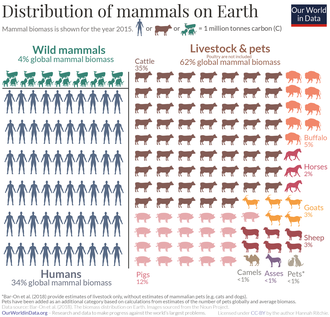
Estimates of the population at the time agriculture emerged in around 10,000 BC have ranged between 1 million and 15 million.[132][133] Around 50–60 million people lived in the combined eastern and western Roman Empire in the 4th century AD.[134] Bubonic plagues, first recorded in the 6th century AD, reduced the population by 50%, with the Black Death killing 75–200 million people in Eurasia and North Africa alone.[135] Human population was believed to have reached one billion in 1800. It has since then increased exponentially, reaching two billion in 1930 and three billion in 1960, four in 1975, five in 1987 and six billion in 1999.[136] It passed seven billion in 2011[137] and passed eight billion in November 2022.[138] It took over two million years of human prehistory and history for the human population to reach one billion and only 207 years more to grow to 7 billion.[139] The combined biomass of the carbon of all the humans on Earth in 2018 was estimated at 60 million tons, about 10 times larger than that of all non-domesticated mammals.[131]
In 2018, 4.2 billion humans (55%) lived in urban areas, up from 751 million in 1950.[140] The most urbanized regions are Northern America (82%), Latin America (81%), Europe (74%) and Oceania (68%), with Africa and Asia having nearly 90% of the world's 3.4 billion rural population.[140] Problems for humans living in cities include various forms of pollution and crime,[141] especially in inner city and suburban slums. Humans have had a dramatic effect on the environment. They are apex predators, being rarely preyed upon by other species.[142] Human population growth, industrialization, land development, overconsumption and combustion of fossil fuels have led to environmental destruction and pollution that significantly contributes to the ongoing mass extinction of other forms of life.[143][144] They are the main contributor to global climate change,[145] which may accelerate the Holocene extinction.[146][143]
Biology
Anatomy and physiology
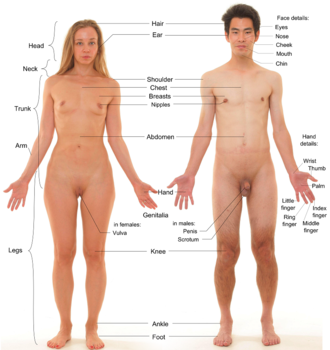
Most aspects of human physiology are closely homologous to corresponding aspects of animal physiology. The human body consists of the legs, the torso, the arms, the neck, and the head. An adult human body consists of about 100 trillion (1014) cells. The most commonly defined body systems in humans are the nervous, the cardiovascular, the digestive, the endocrine, the immune, the integumentary, the lymphatic, the musculoskeletal, the reproductive, the respiratory, and the urinary system.[147][148] The dental formula of humans is: 2.1.2.32.1.2.3. Humans have proportionately shorter palates and much smaller teeth than other primates. They are the only primates to have short, relatively flush canine teeth. Humans have characteristically crowded teeth, with gaps from lost teeth usually closing up quickly in young individuals. Humans are gradually losing their third molars, with some individuals having them congenitally absent.[149]
Humans share with chimpanzees a vestigial tail, appendix, flexible shoulder joints, grasping fingers and opposable thumbs.[150] Apart from bipedalism and brain size, humans differ from chimpanzees mostly in smelling, hearing and digesting proteins.[151] While humans have a density of hair follicles comparable to other apes, it is predominantly vellus hair, most of which is so short and wispy as to be practically invisible.[152][153] Humans have about 2 million sweat glands spread over their entire bodies, many more than chimpanzees, whose sweat glands are scarce and are mainly located on the palm of the hand and on the soles of the feet.[154]
It is estimated that the worldwide average height for an adult human male is about 171 cm (5 ft 7 in), while the worldwide average height for adult human females is about 159 cm (5 ft 3 in).[155] Shrinkage of stature may begin in middle age in some individuals but tends to be typical in the extremely aged.[156] Throughout history, human populations have universally become taller, probably as a consequence of better nutrition, healthcare, and living conditions.[157] The average mass of an adult human is 59 kg (130 lb) for females and 77 kg (170 lb) for males.[158][159] Like many other conditions, body weight and body type are influenced by both genetic susceptibility and environment and varies greatly among individuals.[160][161]
Humans have a far faster and more accurate throw than other animals.[162] Humans are also among the best long-distance runners in the animal kingdom, but slower over short distances.[163][151] Humans' thinner body hair and more productive sweat glands help avoid heat exhaustion while running for long distances.[164]
Genetics

Like most animals, humans are a diploid and eukaryotic species. Each somatic cell has two sets of 23 chromosomes, each set received from one parent; gametes have only one set of chromosomes, which is a mixture of the two parental sets. Among the 23 pairs of chromosomes, there are 22 pairs of autosomes and one pair of sex chromosomes. Like other mammals, humans have an XY sex-determination system, so that females have the sex chromosomes XX and males have XY.[165] Genes and environment influence human biological variation in visible characteristics, physiology, disease susceptibility and mental abilities. The exact influence of genes and environment on certain traits is not well understood.[166][167]
While no humans—not even monozygotic twins—are genetically identical,[168] two humans on average will have a genetic similarity of 99.5%-99.9%.[169][170] This makes them more homogeneous than other great apes, including chimpanzees.[171][172] This small variation in human DNA compared to many other species suggests a population bottleneck during the Late Pleistocene (around 100,000 years ago), in which the human population was reduced to a small number of breeding pairs.[173][174] The forces of natural selection have continued to operate on human populations, with evidence that certain regions of the genome display directional selection in the past 15,000 years.[175]
The human genome was first sequenced in 2001[176] and by 2020 hundreds of thousands of genomes had been sequenced.[177] In 2012 the International HapMap Project had compared the genomes of 1,184 individuals from 11 populations and identified 1.6 million single nucleotide polymorphisms.[178] African populations harbor the highest number of private genetic variants. While many of the common variants found in populations outside of Africa are also found on the African continent, there are still large numbers that are private to these regions, especially Oceania and the Americas.[179] By 2010 estimates, humans have approximately 22,000 genes.[180] By comparing mitochondrial DNA, which is inherited only from the mother, geneticists have concluded that the last female common ancestor whose genetic marker is found in all modern humans, the so-called mitochondrial Eve, must have lived around 90,000 to 200,000 years ago.[181][182][183][184]
Life cycle
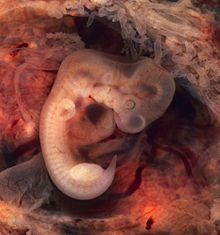
Most human reproduction takes place by internal fertilization via sexual intercourse, but can also occur through assisted reproductive technology procedures.[185] The average gestation period is 38 weeks, but a normal pregnancy can vary by up to 37 days.[186] Embryonic development in the human covers the first eight weeks of development; at the beginning of the ninth week the embryo is termed a fetus.[187] Humans are able to induce early labor or perform a caesarean section if the child needs to be born earlier for medical reasons.[188] In developed countries, infants are typically 3–4 kg (7–9 lb) in weight and 47–53 cm (19–21 in) in height at birth.[189][190] However, low birth weight is common in developing countries, and contributes to the high levels of infant mortality in these regions.[191]
Compared with other species, human childbirth is dangerous, with a much higher risk of complications and death.[192] The size of the fetus's head is more closely matched to the pelvis than other primates.[193] The reason for this is not completely understood,[n 3] but it contributes to a painful labor that can last 24 hours or more.[195] The chances of a successful labor increased significantly during the 20th century in wealthier countries with the advent of new medical technologies. In contrast, pregnancy and natural childbirth remain hazardous ordeals in developing regions of the world, with maternal death rates approximately 100 times greater than in developed countries.[196]
Both the mother and the father provide care for human offspring, in contrast to other primates, where parental care is mostly done by the mother.[197] Helpless at birth, humans continue to grow for some years, typically reaching sexual maturity at 15 to 17 years of age.[198][199][200] The human life span has been split into various stages ranging from three to twelve. Common stages include infancy, childhood, adolescence, adulthood and old age.[201] The lengths of these stages have varied across cultures and time periods but is typified by an unusually rapid growth spurt during adolescence.[202] Human females undergo menopause and become infertile at around the age of 50.[203] It has been proposed that menopause increases a woman's overall reproductive success by allowing her to invest more time and resources in her existing offspring, and in turn their children (the grandmother hypothesis), rather than by continuing to bear children into old age.[204][205]
The life span of an individual depends on two major factors, genetics and lifestyle choices.[206] For various reasons, including biological/genetic causes, women live on average about four years longer than men.[207] As of 2018[update], the global average life expectancy at birth of a girl is estimated to be 74.9 years compared to 70.4 for a boy.[208][209] There are significant geographical variations in human life expectancy, mostly correlated with economic development—for example, life expectancy at birth in Hong Kong is 87.6 years for girls and 81.8 for boys, while in the Central African Republic, it is 55.0 years for girls and 50.6 for boys.[210][211] The developed world is generally aging, with the median age around 40 years. In the developing world, the median age is between 15 and 20 years. While one in five Europeans is 60 years of age or older, only one in twenty Africans is 60 years of age or older.[212] In 2012, the United Nations estimated that there were 316,600 living centenarians (humans of age 100 or older) worldwide.[213]
| Human life stages | ||||
|---|---|---|---|---|
| Infant boy and girl | Zdroj:https://en.wikipedia.org?pojem=Mankind||||
